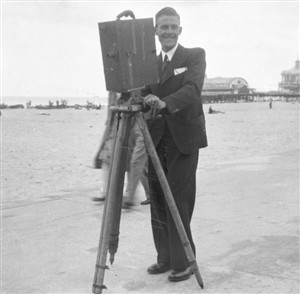
George Meadows with the old Britania Pier Pavilion in the background.
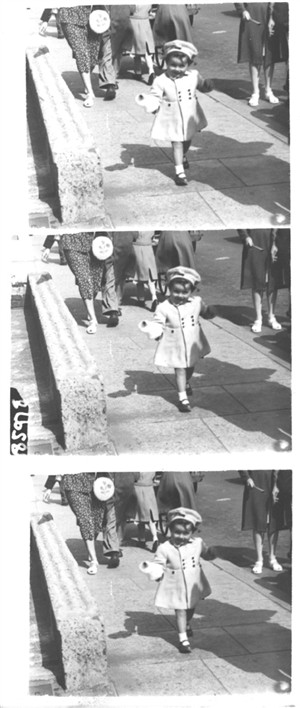
Gail Meadows toddles along near No 53.
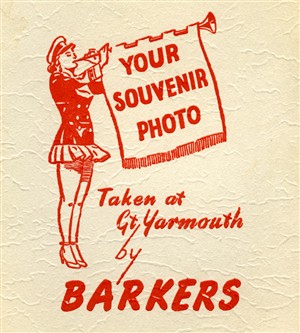
Great Yarmouth logo used by Barkers for many years. Long after the Great Yarmouth Publicity Department had dropped using it.
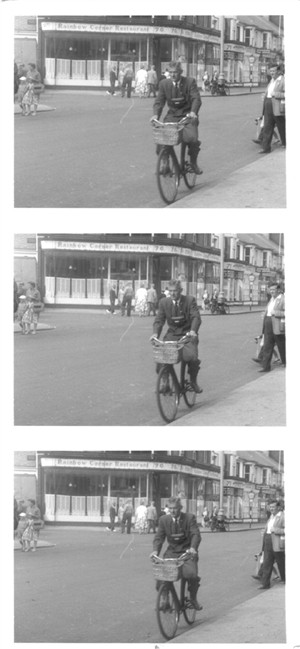
George arrives at 53 Regent Road on his bicycle with his Leica camera around his neck.
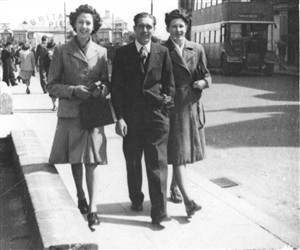
A walkie taken in the afternoon or early evening showing George's wife Joyce on the left.
Walking Pictures
By Paul Godfrey
George Meadows is seen in the top photograph near to the old Brittania Pier Pavilion sometime between 1945 and 1953 with a camera that was taking walking photographs that were known as "walkies." "Walkies" ,no not a command for your dog to walk but a term used to describe photographs taken with these converted 35mm cine cameras. Barkers had several of these devices that were ex-government and were used as cine cameras in the First World War. The cameras were converted for use as still cameras and were operated by the photographer turning the handle once to take series of three photographs that were printed in a strip of 3 prints as shown.
Barkers owned a house number 53 Regent Road Great Yarmouth. The camera was positioned behind the garden wall of no 53 and the holiday makers were snapped as they walked past. They were given a numbered ticket that identified the photograph that they were invited back to 53 Regent Road to view and buy later that day. The photographs were displayed in the front room of the house and vast quantities were sold. 53 Regent Road was eventually turned into a shop.
I assume these cameras held around about 100 feet of film. Ronnie Bean, who worked for Barkers many years, told me these were processed using wooden boards with nails driven in a concentric pattern. In the darkroom the film was wound around the nails and then the boards were dipped into the chemicals. How they dried 100 feet of film in one length one can only guess.
Archie who also worked for many years at Barkers told me he numbered the negatives using a watchmakers eyeglass and a rapidograph pen. The remarkable thing is that you can only write on the emulsion side of the film and he must have written the numbers back to front on each set of three negatives. The shutter on the camera must have been modified to create a black area on the edge of one frame for the number to be written on.
John Barker and Sons was a family business located in Great Yarmouth. John Barker had two sons, Edgar and Leslie who were involved in the photographic business. They continued to run the business after John Barker retired. Edgar went to visit George after WW2 and offered him a job and realising that George had now married he also offered his wife employment.
Edgar organised the photography and processing side at the factory and Leslie was responsible for the shops. Initially there was one shop at 53 Regent Road. They later acquired 16 Regent Road and a number of other locations. Some of the staff George worked with before the war also returned to work there.
There were Archie and Alex and two brothers- Ronnie and Bert Bean. They all worked for the company for very many years. Ronnie operated the processing equipment and did all the running repairs. He was extremely talented and even designed and made several items of equipment. Bert drove the van and made all the deliveries.
George would have operated outside the premises at 53 Regent Road. There was a small shop in what would have been the front room of the house. At the end of the day the camera was stored in the hallway. A relative of the Barkers lived above the shop and would sometimes offer to make tea or coffee for the staff. George took the photographs , a boy was employed to give out the tickets and for a short time George's wife, Joyce, worked in the shop. At busy times the elder Mrs Barker would sit by the door and take the money. As more people started coming to Great Yarmouth for holidays, after the war, the business grew. George spent many long hours along Yarmouth seafront taking pictures, "walkies."
On odd occasions unauthorised people would take photographs and attempt to charge people in advance, they were known as 'Spivs' and were not popular for operating on Barkers territory!
By this time the camera used would have been Leica camera. At a later date Barkers opened a small 'hut' called Wellington Snaps positioned by the side of the Winter Gardens to sell the pictures. Barkers supplied their seafront photographers with bright red jackets and George soon became a very well known and familiar sight along the promenade.